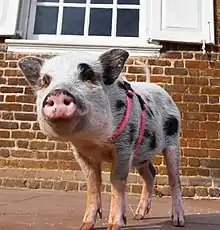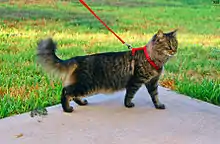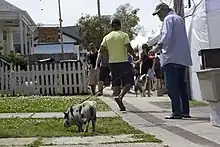Pet harness
A pet harness is equipment consisting of straps of webbing that loop nearly around—that fasten together using side release buckles—the torso of an animal.

These harnesses generally are made to have both a strap on the chest in front of the forelimbs, and a strap around the torso behind the forelimbs, with straps in between connecting these two. Having a D-ring suitable for (pet tags and) a leash to clip to, they are most often used to restrain an animal, but dogs also particularly wear them to assist a person with a disability or haul people and items. There is also the lifting harness for dogs with disabilities, covered in this article.
Some come in different sizes, although many are size-adjustable with tri-glide slides to loosen or shorten the straps’ length. The straps may come in a range of different colors, and some have reflective coating.

For physical restraint

The most common use of the pet harness is for physically restraining an animal. When used as such, the harness is worn in conjunction with a leash; one end of the leash has a metal clip that is attached to the ring on the harness, while the other end is typically a loop held by the human.
While a collar only encircles the neck, harnesses have loops that surround the thorax. This design allows for the distribution of force, which reduces pressure placed on the animal's trachea, and therefore, possesses a significantly lower risk of strangulation. Harnesses also possess a much lesser chance of said animal slipping out than possible if it wears a collar. As such, collars have largely been replaced by harnesses.

Pet clothing frequently sports a properly-placed buttonhole for the D-ring of the harness worn under the garment.
Some harnesses, such as those worn by police dogs, may have a handle so they can be restrained (or lifted) by hand more securely. Such harness (or vest) may bear identification and have bulletproof padding.

Sled dog harnesses
Sled dog harnesses vary depending on whether the dog is hauling freight or racing. Sled dog harnesses come in two main types: the freight harness and the racing harness. Dog sports are growing and more types of harnesses are being developed, including the Y-back style and guard or distance harness. This type of harness is quickly becoming a favorite for those who enjoy skijoring.
The freight harness, often an H-back harness with a wide chest-band and sometimes extra padding, is designed to help the dog pull heavy weights efficiently, and may feature a spreader bar behind the wheel dogs and before the sled or cart. The straps form an 'H' or ladder-like effect across the back of the dog. These harnesses help distribute the weight of the cargo over a broader body area.

Racing harnesses are lighter and shorter than freight harnesses. The X-back harness, so called because the straps form an 'X' across the back of the dog, is used more frequently than the H-back, with short versions that ride farther forward on the dog's body recently gaining in popularity.
The Y-back or hybrid harness is similar in appearance to the H-back. The tugline attaches to the harness on top of the dog's back and stretches parallel to the ground or upwards to the skier, bicycle, or other load.
In contrast, dogs that participate in weight pulls (as compared to a regular freight harness) will wear very heavy, padded harnesses, with broad chest-bands to help spread the weight and prevent harm to the dog.
Assistance dog harnesses
People who are blind or physically disabled are assisted by guide dogs and mobility assistance dogs who wear harnesses with handlebars that their handlers can hold.
Mobility assistance dogs may wear custom-designed harnesses that allow them to bear a small portion of their handlers’ weight so that they may offer balance assistance, counterbalance, bracing and stability. These harnesses usually include a rigid metal bracing handle, but some include lightweight soft handles to allow for minor support.
Guide dogs work in specially designed harnesses which allow the dog to communicate properly with the handler while leading. A handle of a guide dog harness is different than that of a mobility assistance dog one—a guide handle is slanted at an angle to allow for a more natural and comfortable hand position for the handler, and is not intended to bear weight. Custom harnesses for assistance dogs can generally range in price from $100-$600.
Assistance dogs may wear a jacket-, cape-, or vest-style harness that identifies the dog as such and may bear a patch requesting that the dog is not petted or distracted.
Lifting harnesses

A dog lifting harness or dog lifting sling is a harness with at least one handle that wraps around a dog's body to allow a person to help lift the weight off of their hips, spine or legs. There are several different types of them available, each of them providing their own unique advantages. They include: front harness, rear harness, front and rear combo, mid-section support harness, amputee harness and full body harness. There are several conditions that may make it necessary or at least helpful to use a dog lifting harness, some of the most common being: hip dysplasia, broken bones, sprained knees, spine injuries, arthritis, recent surgery, strained muscles and missing limbs.[1]
Car safety harnesses
Safety harnesses designed for use in an automobile restrain the animal in a car seat using the car's seat belt. These harnesses are marketed as reducing the risk of injury to a pet that is riding in a vehicle during a traffic collision. The harnesses are also said to keep the pet from distracting the driver, or escaping from a vehicle.[2][3] The Center for Pet Safety found "a 100-percent failure rate to protect either the consumer or the dog [or other animal]" in a 2013 crash test study of existing car safety harnesses.[3][4] Since then, several car safety harness have been designed that pass crash tests conducted by the Center for Pet Safety.
Legislation
In 2012, New Jersey became the first US state to pass a bill that requires dog and cat owners to restrain their animals while traveling in a moving vehicle. Since the bill's passing, all pets not traveling in a crate and not wearing a safety harness can earn the violator a fine of up to $1,000 and/or six months in prison.[5]
References
- "Pet-Up.com". pet-up.com. Retrieved October 3, 2019.
- "Archived copy". Archived from the original on 2011-09-28. Retrieved 2011-09-26.CS1 maint: archived copy as title (link), Car Safety for Canines, Retrieved on 2011-9-26.
- "Travelling by Car with Pets : The Humane Society of the United States". Humanesociety.org. Retrieved 2012-10-19.
- "Tests On Dog Harnesses Show 100 Percent Failure Rate « CBS Miami". Miami.cbslocal.com. 2013-06-21. Retrieved 2013-09-05.
- Neal, Meghan. "New Jersey says drivers should buckle up their pets, or face a fine". nydailynews.com. Retrieved 5 February 2021.

